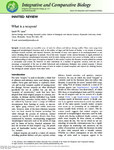What is a weapon?
| dc.contributor.author | Lane, Sarah | |
| dc.date.accessioned | 2020-09-15T08:36:35Z | |
| dc.date.available | 2020-09-15T08:36:35Z | |
| dc.date.issued | 2018-12 | |
| dc.identifier.issn | 1540-7063 | |
| dc.identifier.issn | 1557-7023 | |
| dc.identifier.uri | http://hdl.handle.net/10026.1/16293 | |
| dc.description.abstract |
Animals utilize an incredible array of traits for offence and defence during conflict. These traits range from exaggerated morphological structures such as the antlers of stags and the horns of beetles, to an arsenal of noxious chemicals emitted, secreted, and injected. However, the breadth of these traits appears to be underappreciated in our current thinking about aggression in animals. Use of the term "weapon" in the current literature is largely restricted to studies of conspicuous morphological structures used by males during contests over access to females, and as a result, our understanding of other types of weapons is limited. In this article, I explore the diversity of traits utilized by animals to manipulate and control the behavior of other individuals in a number of agonistic contexts, with the aim to encourage a reappraisal of the way in which behavioral and evolutionary biologists view animal weapons. I discuss the advantages of including this broader range of traits in studies of animal weaponry and explore the unifying features that distinguish animal weapons from other traits. | |
| dc.format.extent | 1055-1063 | |
| dc.format.medium | ||
| dc.language | en | |
| dc.language.iso | eng | |
| dc.publisher | Oxford University Press (OUP) | |
| dc.subject | Aggression | |
| dc.subject | Animals | |
| dc.subject | Behavior, Animal | |
| dc.subject | Biological Evolution | |
| dc.subject | Female | |
| dc.subject | Invertebrates | |
| dc.subject | Male | |
| dc.subject | Sex Characteristics | |
| dc.subject | Sexual Behavior, Animal | |
| dc.subject | Vertebrates | |
| dc.subject | Weapons | |
| dc.title | What is a weapon? | |
| dc.type | journal-article | |
| dc.type | Journal Article | |
| dc.type | Research Support, Non-U.S. Gov't | |
| plymouth.author-url | https://www.webofscience.com/api/gateway?GWVersion=2&SrcApp=PARTNER_APP&SrcAuth=LinksAMR&KeyUT=WOS:000456584300004&DestLinkType=FullRecord&DestApp=ALL_WOS&UsrCustomerID=11bb513d99f797142bcfeffcc58ea008 | |
| plymouth.issue | 6 | |
| plymouth.volume | 58 | |
| plymouth.publication-status | Published online | |
| plymouth.journal | Integrative and Comparative Biology | |
| dc.identifier.doi | 10.1093/icb/icy083 | |
| plymouth.organisational-group | /Plymouth | |
| plymouth.organisational-group | /Plymouth/Faculty of Science and Engineering | |
| plymouth.organisational-group | /Plymouth/Faculty of Science and Engineering/School of Biological and Marine Sciences | |
| plymouth.organisational-group | /Plymouth/Users by role | |
| plymouth.organisational-group | /Plymouth/Users by role/Academics | |
| dc.publisher.place | England | |
| dc.identifier.eissn | 1557-7023 | |
| dc.rights.embargoperiod | Not known | |
| rioxxterms.versionofrecord | 10.1093/icb/icy083 | |
| rioxxterms.licenseref.uri | http://www.rioxx.net/licenses/all-rights-reserved | |
| rioxxterms.type | Journal Article/Review | |
| plymouth.funder | The role of additive and non-additive genetic effects during animal contests in the beadlet sea anemone Actinia equina::BBSRC |


